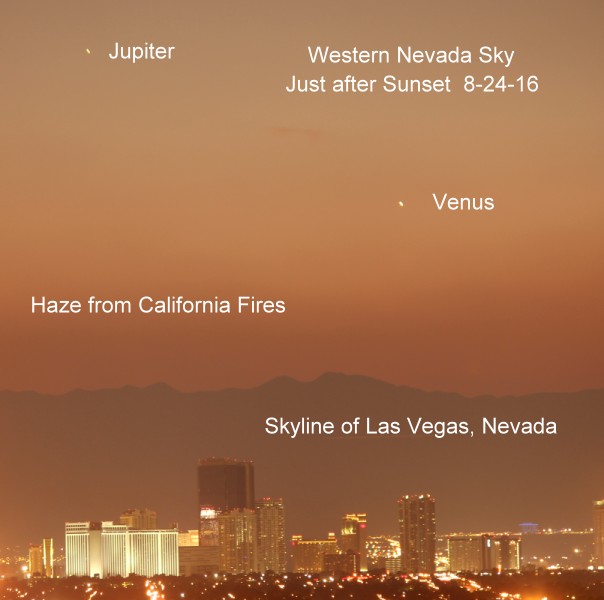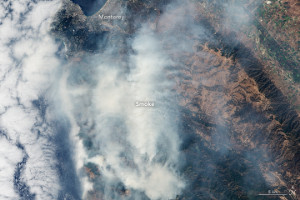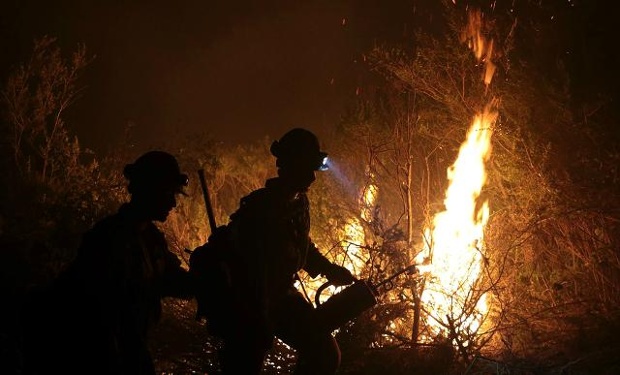A warmer climate has helped send thousands of square miles up in flames, says a new study, which links climate change with the wildfire increase.
A new study published October 10, 2016 in the peer-reviewed journal Proceedings of the National Academy of Sciences links climate change to the increase in wildfires over recent decades. The authors teased out the effects of climate warming from other factors after analyzing and comparing eight different systems for rating forest aridity (more about that below). They concluded that – over the last 30 years – climate change has doubled the area affected by forest fires in the U.S. West.
The study comes from Columbia University’s Lamont-Doherty Earth Observatory. It shows that, since 1984, heightened temperatures and resulting aridity have caused fires to spread across an additional 16,000 square miles [41,000 square km] than they would have otherwise. That’s an area in the U.S. West larger than the states of Massachusetts and Connecticut combined, the authors said.
Study authors looked at eight different systems for rating forest aridity including the Palmer Drought Severity Index, the MacArthur Forest Fire Danger Index and the Canadian Forest Fire Danger Rating System.
They then compared such measurements with observations of actual fires and large-scale climate models that estimate human-influenced climate warming.
The crunched data showed that 55 percent of the increase in fuel aridity expected to lead to fires could be attributed to human-influenced climate change.
Study coauthor A. Park Williams, a bioclimatologist at Lamont-Doherty, commented:
No matter how hard we try, the fires are going to keep getting bigger, and the reason is really clear. Climate is really running the show in terms of what burns. We should be getting ready for bigger fire years than those familiar to previous generations.
The scientists’ statement says that wildfires in western forests began increasing abruptly in the 1980s, as measured by area burned, the number of large fires, and length of the fire season.
A warmer climate drives fire by drying out the land. Warmer air can hold more moisture, and the air ends up sucking it out of plants, trees, dead vegetation on the ground, and soil. According to these scientists, average temperatures in forested parts of the U.S. West have gone up about 2.5 degrees F since 1970, and are expected to keep rising. The resulting drying effect is evident in the rise of more fires.
Study authors said that the overall increase in fire since the 1980s is about twice what the researchers attribute to climate change; the rest is due to other factors, they say. One has been a long-term natural climate oscillation over the Pacific Ocean that has steered storms away from the western United States. Another: firefighting itself. By constantly putting out fires, authorities have allowed areas they “saved” to build up more dry fuel, which later ignites, causing ever more catastrophic blazes, the researchers say.
They added that they don’t account for some factors that could be offshoots of climate warming, for example, the millions of trees killed in recent years in the U.S. West by beetles that prefer warmer weather, and declines in spring soil moisture brought on by earlier snowmelt. There is also evidence that lighting—the usual initial spark—may increase with warming, they said.
They pointed out that wildf ires of all kinds have been increasing not just in the U.S., but around the globe, often with a suspected climate connection.
ires of all kinds have been increasing not just in the U.S., but around the globe, often with a suspected climate connection.
And they said that many scientists studying the issue believe the growth in U.S. western fires will continue for many years. Williams and others say that eventually, so many western forests will burn, they will become too fragmented for fires to spread easily, and the growth in fire will cease. But, he said:
… there’s no hint we’re even getting close to that yet. I’d expect increases to proceed exponentially for at least the next few decades.
In the meantime, he said:
It means getting out of fire’s way. I’d definitely be worried about living in a forested area with only one road in and one road out.
Robert Kelly in Las Vegas, Nevada caught this photo of Venus and Jupiter in the west after sunset on August 24, 2016. He wrote: “The California wild fire haze covered up Mercury.”
Bottom line: A new study from Columbia University’s Lamont-Doherty Earth Observatory says that human-induced climate change has doubled the area affected by forest fires in the U.S. West over the last 30 years.








